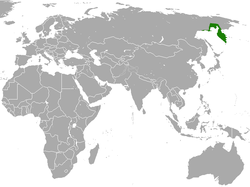| Kamchatka shrew | |
|---|---|
| Scientific classification | |
| Kingdom: | Animalia |
| Phylum: | Chordata |
| Class: | Mammalia |
| Order: | Eulipotyphla |
| Family: | Soricidae |
| Genus: | Sorex |
| Species: | S. camtschatica |
| Binomial name | |
| Sorex camtschatica Yudin, 1972 | |
 | |
| Kamchatka Shrew range | |
The Kamchatka shrew (Sorex camtschatica) is a species of mammal in the family Soricidae. It is endemic to Russia.
